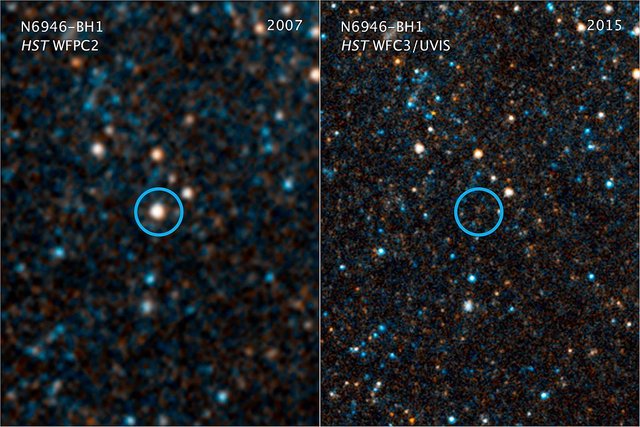Someone stole a star - (and I didn't have my insurance paid)
Imagine, a demolition guy placing his charges, triggering the detonator that is at a safe distance, and nothing happens... The TNT didn't blow. But, also, the TNT is gone!!! It vanished. Yes we could blame some neighbor that wants to utilize the explosives to celebrate his mother-in-law's birthday...
Something similar happened to some astronomers that for years have been observing a dying giant. Instead of blowing up, transitioning into a supernova: It simply vanished.
What the researchers believe happened is that it collapsed on itself with no explosion of any kind; it transformed direclly into a black hole (here's where the mother-in-law's birthday example kicks in). If this theory is right, we'd been the first witnesses in the recorded human history of the birth of a black hole.
A supernova marks the final stage of the majority of the massive stars with in the Universe. When the core of a giant star collapses, a powerful shock-wave expels the layers that cover it: Most parts of the star are ejected into space, it goes "kaboom". The collapsed core converts into an extremelly dense object: A neutron star or a black hole.
(Yes the audio choice is awful here)
Several explosions of this kind have been observed before, yet very few match this particularly large mass. Some theories already predicted that they could entirelly collapse, or at least, partially, to reach the mass of a black hole, with no supernova explosion.
Christopher Kochanek and his team, since 2008 searched for hints of these "failed" supernovas. So far, there's only one object that earned his attention. It is at the NGC 6946 galaxy, known as "Pyrobolus Cygni" ("Fireworks Galaxy"). A giant star's brightness, with a mass 25 times the one of our Sun, N6946-BH1, increased for months. It looked as if the end was coming, everyone was expecting to document the sueprnova... But it vanished, in 2015 it was nearly invisible.

Not even the combined power of the Hubble and Spitzer (an IR telescope, infrared) telescopes were able to see the missing star. At the infrared spectrum there's a remaining "aura" that can be seen in the original location, to weak to come from a star.
Several explanations were discarded; like, dusts of cloud blocking the view. It was conclusive that N6946-BH1 colapsed into a black hole. The infrared aura comes from residual gases, that originally belonged to the surface of the star: Now it is slowly being absorbed back into the black hole.
This kind of research helps us understand how frequently these sort of events happen: N6946-BH1 is the only probable supernova fail that was found during years of research. So far, we can calculate that around 10-30% of the massive stars die as failed supernovas.
Sadly, we were born too early in the history of humankind to be able to witness such events "live" and in "first person view". Luckily, it is up to US to develop the needed technologies that will allow our nieces, perhaps grandnieces, to do so!
Nice post from @renzoarg. I'm upvoting right now! I've upvoted. Thanks for sharing!
That would be a sight to see.
Its so incredible to be alive in this time. The things we are witnessing and experiencing are things the greatest bards could never dream of. Witnessing theories become more sound too is phenomenal at this scale!
To what I remember, searches for failed supernovae are still very active. This offers ways to learn :)
I sometimes think about what my teenage daughter will see in the future.
Nice post i follow !
Look also at my page, i'm astrophographer :)